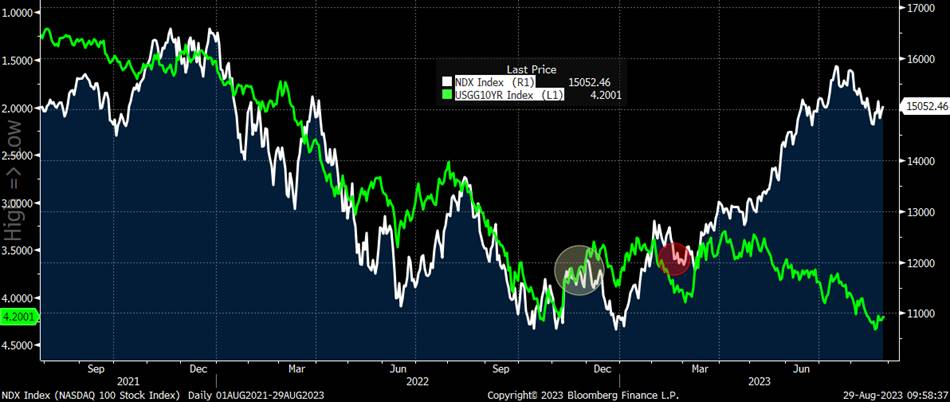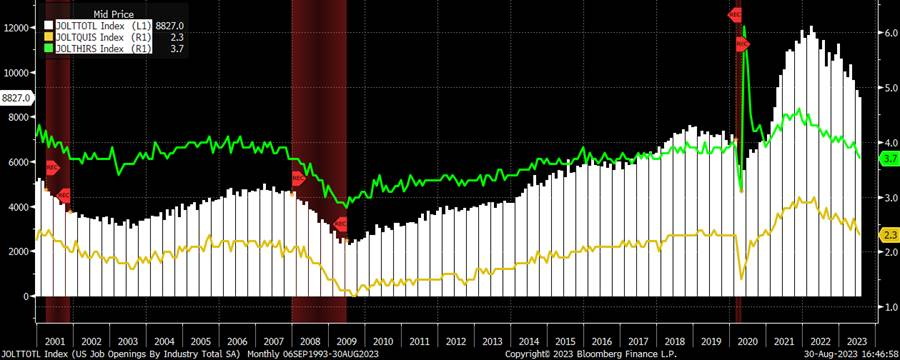
“China’s economy is not as dire as media headlines might suggest. Chinese equities are setting up to be a good buy. Patience will be rewarded”
Summary
China’s GDP is set to grow by +5.2% for the whole of 2023, as per International Monetary Fund (IMF) estimates. Is that growth rate bad for a $19 trillion economy? It translates to an addition of $1 trillion in growth annually. A growth rate exceeding +5% in GDP, is certainly commendable, especially when compared to the US at +2%, the UK & France at sub +1%, and Germany currently in a recession.
China’s economy is not as dire as media headlines might suggest. China, however, has structural challenges – including debt concerns, diminishing productivity, a contracting workforce, elevated youth unemployment, a technological trade dispute with the US, and an ongoing rectification of the real estate bubble. China is actively addressing the slowdown and is steering its economy towards a trajectory of growth driven by consumption, as opposed to the property investment and export-led growth patterns observed thus far. Chinese economy is not ailing but evolving. Chinese equities are setting up to be a good buy. Patience will be rewarded.
The US labour market is approaching a state of “normalization,” and an unemployment rate adjustment appears imminent. Inflation within the services sector, has demonstrated stubborn resilience. As labour constitutes a significant component of services inflation, a cooling job market is poised to contribute to a further decline in services inflation. The prospect of additional interest rate hikes has been a prevailing concern for markets, and especially for technology stocks. However, as the job market normalises and services inflation recedes, the urgency for rate hikes is likely to diminish rapidly. This shift in dynamics could provide a boost to US equities, propelling them to higher levels by the end of the year.
China: “ailing” or “evolving”?
Once again, a renewed consensus has surfaced within the same cohort of economists, journalists, analysts, and experts who appear to emerge collectively to advocate their rendition of the “China is facing difficulties” narrative.
The Economist is out with a cover “Xi’s failing model” and accompanying article – Why China’s economy won’t be fixed. If you search on Google using the phrase “The Economist cover on China,” you will encounter a series of their commentaries spanning over two decades.
Their cover story – “The Great fall of China” from August 2015, is one of my favourites. Interestingly, since then, China’s GDP has surged by +72%, growing from $11 trillion to $19 trillion. The “great fall” saw China’s GDP fall upward! I am sure China (and the world) could do well with more such “great falls.”
China’s economy has structural challenges – including debt concerns, diminishing productivity, a contracting workforce, elevated youth unemployment (presently exceeding +20%), a technological trade dispute with the US, and an ongoing rectification of the real estate bubble. Nevertheless, these are predicaments that China acknowledges and is actively addressing. Some of these challenges are not exclusive to China, but also afflict the Western world.
These challenges mean that China’s growth will not return to the +10% p.a. growth that sustained from 1980 to 2010.
However, that doesn’t mean that its all doom and gloom. In fact, far from it.
1. China’s GDP growth in the second quarter of 2023, picked up to +6.3% and is set to grow by +5.2% for the whole year, as per International Monetary Fund (IMF) estimates. Is +5.2% growth rate bad for a $19 trillion economy? It translates to an addition of $1 trillion in growth annually.
2. China’s imports have exhibited a decline of -7.6% during the initial seven months of 2023, potentially indicating subdued domestic demand. Yet, this reduction in nominal import growth can be entirely attributed to price-related factors. On the contrary, when assessed in terms of volume, imports expanded by +1.0% compared to a -6.4% contraction during the same period the previous year. Therefore, imports in the first half of 2023 suggest a strengthening domestic demand.
3. Regarding the “price effects” mentioned in the preceding point, it’s worth recalling that in the last month’s Market Viewpoints, I highlighted the looming spectre of disinflation faced by China (and much of the global economy). Subsequent to that, another reading of China’s consumer price index (CPI) has emerged, revealing a state of deflation with a decline of -0.3% from the previous year in July (see chart below). China’s producer price index (PPI) which measures the costs associated with producing consumer goods, has been negative since last September, and continues to be so. This situation hints at a more profound underlying dynamic, leading me to harbour a stronger conviction than before, that the Western world is inching closer to experiencing disinflation, and this might occur sooner rather than later.
4. Chinese households are increasing spending, not slashing, as some headlines suggest. For the first half of 2023, per capita consumption expanded by +8.4%, exceeding the +6.5% growth of per capita disposable income.
5. The growth of average per capita wages in the first half of 2023 was +6.8%. And, considering other sources of income, such as interest and other property income, per capita after-tax income was almost three-quarters larger than wage income and rose +6.5%, exceeding the growth of nominal GDP. Thus, the share of output accruing to households is now rising, not falling. As Nicholas Lardy of the Peterson Institute for International Economics (PIIE) reminds us, the combination of rising personal incomes and a falling savings rate, means that future household consumption growth will likely surprise to the upside.
China Consumer Price Index (CPI) and China Producer Price Index (PPI): Year-on-Year growth

Source: Bloomberg
The Chinese government’s abrupt and badly managed crackdown on privately-owned internet platform companies, which commenced in late 2020, inflicted severe damage to their profits, investments, and workforce expansion. The government has learned its lessons.
In July 2023, China’s regulatory authorities provided a green light, affirming that the financial concerns pertaining to internet companies have been effectively addressed. In response, major firms such as Alibaba, ByteDance, Meituan, and others have embarked on a hiring spree, reversing the tide of layoffs that had affected private tech enterprises in 2022. Looking ahead, these companies’ profitability under the framework of the new “normalized supervision” model is projected to be somewhat less robust than the period preceding 2020. However, their stocks remain undervalued and oversold, suggesting substantial potential for growth. That growth is likely to catalyse a resurgence in overall private investment growth within China.
Based on the latest data from the International Monetary Fund (IMF), the United States boasts a GDP of $26.9 trillion, whereas China’s GDP stands at $19.4 trillion. Over the past half-decade, China’s GDP has exhibited a steady annual growth of +6.1%, in contrast to the United States, which has recorded a more modest +2.1% annual growth. As per IMF projections, China’s economy is anticipated to expand by +5.2% in the current year, while the US economy is predicted to achieve a growth rate of +1.6%.
Yet, if you look at how US equities and Chinese equities have performed (see chart below), you’d think China is in the throes of an economic downturn, as the S&P500 Index has outperformed the Shenzhen CSI 300 Index by a substantial margin of almost 90%, since the nadir of the COVID-19 pandemic in mid-2020.
In terms of index metrics, the S&P500 commands price-to-earnings (P/E) and price-to-book value (P/B) ratios of 20x and 4.2x, respectively. On the other hand, the Shenzhen CSI 300 is characterized by a P/E ratio of 12x and a P/B ratio of 1.6x.
Meanwhile, Beijing’s persistent efforts to rejuvenate investor confidence suggest that the decline in Chinese equities has reached a threshold that policymakers can no longer disregard. China has recently implemented a series of measures and has committed to further actions to reinvigorate economic recovery and enhance the business environment, responding to mounting concerns about growth.
S&P500 Index v Shanghai Shenzhen CSI 300 Index: 4-year price chart

Source: Bloomberg
A barrage of statements from the government and the Chinese Communist Party (CCP) since July has predominantly centred on boosting the stock market, promoting increased expenditure on consumer goods and automobiles, and encouraging private enterprises to expand their investments. With two interest rate cuts already witnessed this year, the prospect of more cuts looms on the horizon.
This suggests to me that China is actively addressing the slowdown and is steering its economy towards a trajectory of growth driven by consumption, as opposed to the property investment and export-led growth patterns observed thus far.
Beijing isn’t going to unleash a broad economy wide fiscal stimulus that many on Wall Street have come to expect of China. Unlike the West, China refrained from expanding its balance sheet extensively, to counter the demand decline caused by the COVID-19 pandemic.There were no direct cash disbursements to consumers then, and it’s likely that such measures won’t be introduced now either. Heavily indebted local governments in China will likely need to compete for favourable treatment from Beijing.
Stimulus, market reforms, and rate cuts will continue to get implemented incrementally. There won’t be any “bazooka” if that’s what some are waiting for.
China’s economy is not as dire as media headlines might suggest. A growth rate exceeding +5% in GDP is certainly commendable, especially when compared to the US at +2%, the UK & France, at sub +1%, and Germany currently in a recession.
Though real estate challenges will persist as struggling entities encounter difficulties, corporations that engaged in quick gains through property market speculation, will not be the beneficiaries of bailouts. Also, the era in China where rising property values were utilized for wealth accumulation and homes were treated as cash-dispensing “Automatic Teller Machines” (ATMs) has ended. President Xi Jinping’s distinctive motto, “houses are for living, not for speculation,” underscores this transition.
Those looking for China’s “Lehman moment” will be sorely disappointed too for a simple reason – the majority of Chinese banks are entirely state-owned. If banks get into trouble, they’ll get bailed out to prevent a Lehman-like outcome. The People’s Bank of China (PBoC) wants to cut interest rates further, but they are also mindful of hurting the profitability of Chinese banks.
On careful analysis of all available evidence, I would opine that the Chinese economy is not ailing, but evolving. The economic recovery from the impact of Covid-19 has begun, but the recovery remains fragile. Chinese equities are setting up to be a good buy. Patience will be rewarded.
Markets and the Economy
Former US President Harry Truman famously yearned for a straightforward economist who didn’t offer contradictory perspectives: “Give me a one-handed economist. All my economists say ‘“on the one hand…,” then, “but on the other…’”
Had Truman been alive today and heard US Federal Reserve (Fed) Chair Jerome Powell’s speech at the Kansas City Fed’s annual symposium in Jackson Hole, Wyoming last seek, he would likely not have been amused.
Powell’s speech embodied the quintessential “on-the-one-hand, on-the-other-hand” manner of discourse. He conveyed that the Fed’s rate hikes “are now working together to bring down inflation,” while simultaneously emphasizing that “the process still has a long way to go.”
To investors seeking clarity on the timing of potential rate cuts (or indeed, if there are more rate hikes), this speech might seem to be as clear as mud.
Despite what Powell is saying, the Fed is unlikely to raise interest rates further.
The Fed seems to be engaged in a strategy of “expectations management” to prevent prices from once again spiralling out of control. The Consumer Price Index (CPI) has declined from +9% to +3%. By leaving open the possibility of raising rates for longer, without actually raising them, Powell aims to moderate the expectation that the Fed will not hastily slash rates upon a pivot. This tactic is designed to signal both to the market and to consumers that the elevated rate environment might endure.
Throughout the bear market for stocks in 2022, the high-growth National Association of Securities Dealers Automatic Quotation System (NASDAQ) 100 Index exhibited an almost perfect inverse correlation with the yield on the 10-Year US Treasury.
As Treasury yields experienced an upswing, the Nasdaq declined, and conversely, when yields showed signs of levelling off, the Nasdaq saw a rebound. However, during the fourth quarter of the preceding year and the first quarter of the current year, the previously steadfast inverse relationship between the two began to unravel, leading to a substantial divergence over the last six months. Remarkably, the Nasdaq has demonstrated robust growth this year, even as the yield on 10-Year Treasury’s, has surged to new cycle highs.
So, what triggered the breakdown in the connection between the NASDAQ 100 and the US 10-Year yield?
A significant contributing factor appears to be the flourishing AI (Artificial Intelligence) trend.
Investors seem to have shifted their focus beyond short-term anxieties anbout elevated interest rates, embracing the potential long-term opportunities that the “AI” revolution could usher in. This shift in sentiment is particularly evident in the timing of key events.
ChatGPT, which catalysed the new AI wave, was unveiled on November 30, 2022 (indicated by the white circle in the chart below), shortly after US equities reached their bear market lows. Additionally, Nvidia’s (NVDA) Q4 2022 earnings report in late February 2023 (depicted by the red circle in the chart below) played a pivotal role in intensifying investor enthusiasm for AI-related prospects.
NASDAQ 100 vs. 10-Year Treasury Yields (inverted): last 24 months

Source: Bloomberg
Last week, NVDA reported its earnings for Q2 2023 and it was another stellar report.
Back in May, NVDA had projected Q2 revenue to hover around $11 billion, a staggering $4 billion higher than Wall Street’s predictions. However, the latest report disclosed actual Q2 revenue of $13.5 billion. This figure is twice what analysts had conservatively estimated for NVDA’s Q2 revenue, as recently as May. Notably, NVDA also indicated that its revenue for the current quarter would reach approximately $16 billion, surpassing expectations by about $3.5 billion.
Such a run obviously can’t last forever, but Nvidia gave strong indications that its ride is far from over. Chief Financial Officer, Colette Kress said on the company’s earnings call that its “demand visibility” extends into next year and that it expects to be able to increase the availability of its chips over the next several quarters.
It seems NVDA’s AI surge is just getting started.
In terms of noteworthy economic data past few days, the latest US Job Openings and Labor Turnover Survey (JOLTS) certainly made heads turn.
- Data suggests US job openings are falling rapidly (JOLTTOTL, chart below). Job openings for July dipped to 8.8 million, reflecting a substantial decrease over the past few months. This drop follows a period during which job openings peaked at 12 million in March 2022 and hovered around 10 million at the close of 2022. In one of the most cyclical sectors – construction, layoffs increased by 49,000 in July compared to June 2023
- The quits rate (JOLTQUIS) is now below pre-pandemic levels, falling to 2.3%, a touch below the peak observed in 2019. The quits rate among private sector workers fell to 2.5%, well below the most recent peak of 3.3% in April 2022. The enthusiasm for quitting jobs, which characterized the COVID era, seems to be waning. It appears that people still prioritize having jobs
- The hires rate (JOLTHIRS) has also decreased noticeably beneath pre-pandemic levels, currently standing at 3.7%. In 2019, this rate stood closer to +4.0%. This represents another indicator of a cooling labour market
US Job Openings and Labor Turnover Survey (JOLTS) survey

Source: Bloomberg
These indicators collectively suggest that the US labour market is approaching a state of “normalization,” and an unemployment rate adjustment appears imminent. Consequently, it’s time for the US Fed to redirect its focus from the frequently cited ratio of “job openings to unemployed workers”, which remains at 1.5. While this ratio persists, the US job market is signaling potential challenges ahead.
August proved to be a month of consolidation for US equities.
The S&P 500 index (SPX) finished in the red so did the tech heavy NASDAQ 100 index (see table below). However, on a YTD basis, both indices are up handsomely, +17% and +33% respectively.
However, as September approaches, further consolidation might be in the offing, due to historical seasonal patterns. Over the past decade, September has consistently been the weakest phase of the late summer and early fall consolidation period.
Benchmark Global Equity Index Performance (2022; 2023 YTD and MTD)

Inflation within the services sector, has demonstrated stubborn resilience. As labour constitutes a significant component of services inflation, a cooling job market is poised to contribute to a further decline in services inflation. This development is promising and offers additional relief to the Fed’s concerns about inflation.
The prospect of additional rate hikes has been a prevailing concern for markets and especially for technology stocks. However, as the job market normalises and services inflation recedes, the urgency for rate hikes will diminish rapidly. This shift in dynamics could provide a boost to US equities, propelling them to higher levels by the end of the year.
As I keep reiterating – Structured Products are a very useful means of investing in equities. They offer a degree of capital protection, while at the same time helping pick good entry points in the market, and offering means to clip coupons, in a flat to negative market.
For specific stock recommendations and ideas related to structured products, please feel free to reach out to me or your relationship manager.
Best wishes,

Manish Singh, CFA

